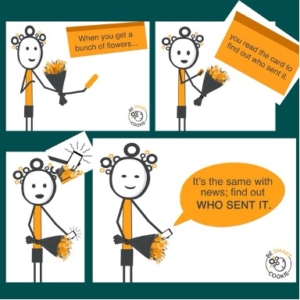Why writing in plain English matters for charities
A practical guide to using plain English to cut through the noise, reach more people, and make every word count.
Posted 23 June 2025

Janette Ballard is not a fan of top tips. But she does have ideas on how to think about tackling online misinformation for charities using critical thinking tools. Read on to explore Janette’s critical thinking tools that will help your charity challenge misinformation and reduce the noise smartly and safely.
Is your charity equipped to tackle misinformation? Does your charity know what misinformation is? As more and more charities expand their digital presence on platforms such as TikTok, it’s vital that they know how to spot and challenge misinformation. Information expert Janette Ballard talks us through her tried and tested critical thinking tools that help cut through the online noise.
Be mindful of the difference between fact and opinion. Facts are statements you can show to be true. An opinion is a point of view. It may be based on fact, reasonable and from an expert, but it is still opinion.
Of course, a charity has a point of view, an opinion – people expect that. But you have a responsibility to make your content as transparent as possible by being clear on the distinction. Doing this will help build and protect your reputation as a reliable organisation.
So, remember; both facts and opinions need to be fully referenced and context provided somewhere, even if it’s ‘visit our website for more information’.

It’s vital to know where your information comes from, especially if you intend to use that information in your comms and social media. In our real world lives, often without thinking about it, we check where things come from all the time. It’s the same online – as this cartoon explains.
Once you know the source of the information you can start to ask whether it’s trustworthy. Of course, even the most trusted source will get it wrong sometimes. And what’s trustworthy for one person, may not meet the criteria for another. But there are three useful questions you can ask to help figure it out.
What is it I want to know and who is best placed to tell me?
If you want to know what the No. 1 album of the year is, a police social media feed is unlikely to tell you. But your local radio station or music publication will.
So, evaluate the source in terms of what it is you want to know.
What do I know about this source?
Delve into as much detail as you can; what do I know about this source’s reputation? Does this source correct its mistakes? What motivates this source; Money? Power? Politics? Ideology?
What bias am I bringing to the question of whether to trust this source?
If a source thinks – or looks – like us, we have a tendency to regard them as more reliable than a source who does not.
The same three questions can help when you are producing content. You can increase trust and transparency in your charity’s communications if, when appropriate, you;
There’s an area of misinformation that I like to describe as ‘messy’. It comes out of the production process, rather than any deliberate decision on anyone’s part to mislead or publish something untrue or fake. Broadly, it’s called; editing.
All published content from newsrooms to individuals has been edited. Decisions have been taken about what to include and what not to include. But all those decisions affect how the story is presented.
These editorial choices are particularly pertinent to how the charity sector use social media. Social media is short, to the point and needs to cut through the noise. For each editorial decision you take, ask yourself why you are taking it. Here are some examples;
Don’t get me wrong, editing is not bad or wrong. It’s often wise; it might protect a vulnerable contributor or correct a common misconception. But by being aware of how your decisions are impacting the final product will help you stay on the right side of the fine line between impact and manipulation.
Navigating online information and misinformation is a way of thinking. Be curious, be critical. You will not stop and/or catch all misinformation, so it’s important so pick your battles. And in the meantime, try not to add too much to the noise in your own content production.
Return to the resource hubA practical guide to using plain English to cut through the noise, reach more people, and make every word count.
Posted 23 June 2025

How to make every minute of your limited schedule count.
Posted 23 June 2025

Top tips for sharing your volunteering experience loud and proud
Posted 4 June 2025
